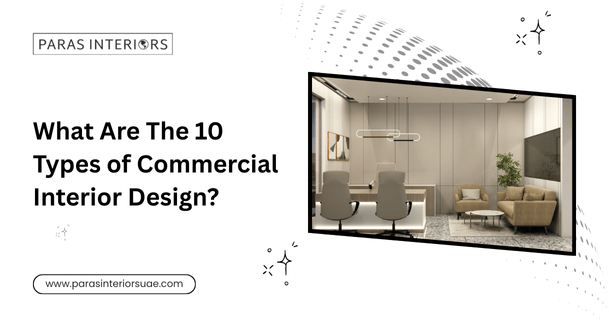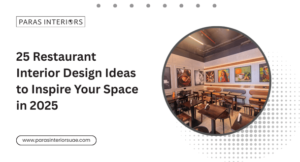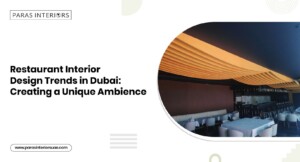
What Are The 10 Types of Commercial Interior Design?
Summary:
Discover the essential types of commercial interior design, from corporate offices to wellness centers. This guide outlines the unique features and benefits of each style, helping businesses choose the best approach for their needs.
Commercial interior design transforms workspaces into functional, aesthetically pleasing environments that drive business success. Whether you’re planning an office renovation or launching a new retail venture, understanding the different types of commercial interior design helps you make informed decisions that align with your brand goals.
From corporate offices to hospitality venues, each commercial space serves unique purposes and requires specialized design approaches. This comprehensive guide explores ten distinct types of commercial interior design, their key characteristics, and how they benefit businesses across various industries.
1. Corporate Office Interior Design
Corporate office interior design focuses on creating productive work environments that reflect company culture and values. Modern corporate spaces emphasize collaboration, flexibility, and employee wellbeing through thoughtful space planning and design elements.
Key features include open-plan layouts balanced with private meeting areas, ergonomic furniture, and technology integration. Color schemes typically use neutral palettes with strategic accent colors that reinforce brand identity. Natural lighting and biophilic design elements improve employee satisfaction and productivity.
Successful corporate interior design for commercial spaces considers workflow patterns, departmental needs, and future growth potential. The result is a professional environment that attracts talent while supporting business operations.
2. Retail Store Interior Design
Retail interior design psychology drives purchasing decisions through strategic layout, lighting, and visual merchandising. This commercial interior design style creates immersive brand experiences that guide customers through their shopping journey.
Effective retail design incorporates traffic flow optimization, product highlighting techniques, and sensory engagement strategies. Lighting plays a crucial role in product presentation, while color psychology influences mood and buying behavior. Flexible fixtures allow for seasonal updates and inventory changes.
Commercial interior design examples in retail include flagship stores, boutiques, and department stores. Each requires different approaches based on target demographics, product categories, and brand positioning.
3. Restaurant and Hospitality Interior Design
Restaurant interior design balances ambiance, functionality, and operational efficiency. This commercial interior designing specialty creates memorable dining experiences while meeting strict health and safety regulations.
Design considerations include kitchen workflow, seating capacity optimization, and acoustic management. Material selection focuses on durability, easy maintenance, and hygiene requirements. Lighting design creates mood while ensuring adequate visibility for dining and staff operations.
Hospitality commercial interior design styles vary dramatically based on concept and target market. Fine dining establishments emphasize luxury and intimacy, while fast-casual restaurants prioritize efficiency and turnover.
4. Healthcare Facility Interior Design
Healthcare interior design prioritizes patient comfort, staff efficiency, and infection control. This specialized commercial interior design field requires extensive knowledge of medical regulations and operational requirements.
Key elements include wayfinding systems, privacy considerations, and therapeutic color schemes. Material selection emphasizes antimicrobial properties, durability, and easy cleaning protocols. Natural light integration and healing environments reduce patient stress and support recovery.
Healthcare commercial design encompasses hospitals, clinics, dental offices, and specialized treatment facilities. Each requires specific design solutions to meet regulatory compliance while creating welcoming environments.
5. Educational Institution Interior Design
Educational interior design creates inspiring learning environments that support diverse teaching methods and student needs. This commercial interior design approach considers age-appropriate layouts, safety requirements, and technological integration.
Design features include flexible classroom configurations, collaborative learning spaces, and sensory considerations for different learning styles. Color psychology impacts student behavior and concentration levels. Durability and maintenance requirements drive material selection.
Commercial interior design examples in education range from elementary schools to universities, each with unique requirements. Design solutions must balance budget constraints with long-term functionality and safety standards.
6. Hotel and Lodging Interior Design
Hotel interior design creates memorable guest experiences while maximizing operational efficiency. This hospitality-focused commercial interior design style balances luxury aesthetics with practical considerations like housekeeping requirements and durability.
Design elements include brand-consistent theming, space optimization in guest rooms, and creating distinct experiences in public areas. Lighting design supports both functionality and ambiance throughout different times of day. Material selection emphasizes comfort, cleanliness, and longevity.
Commercial interior design styles in hospitality vary from budget accommodations to luxury resorts, each requiring different approaches to meet guest expectations and operational needs.
7. Industrial and Warehouse Interior Design
Industrial interior design optimizes workflow efficiency while ensuring worker safety and comfort. This commercial interior design specialty addresses unique challenges including heavy equipment integration, environmental controls, and regulatory compliance.
Key considerations include traffic flow for vehicles and personnel, lighting for safety and productivity, and ventilation systems. Material selection emphasizes durability, chemical resistance, and ease of maintenance. Color coding and wayfinding systems improve operational efficiency.
Interior design for commercial spaces in industrial settings must balance cost-effectiveness with long-term functionality and worker wellbeing.
8. Entertainment Venue Interior Design
Entertainment venue design creates immersive experiences that enhance performances and events. This dynamic commercial interior designing field encompasses theaters, concert halls, sports venues, and recreational facilities.
Design priorities include acoustics, sightlines, crowd flow management, and safety considerations. Lighting systems must accommodate both ambient and performance requirements. Material selection considers high-traffic wear patterns and maintenance accessibility.
Commercial interior design examples in entertainment include multiplex cinemas, gaming centers, and event spaces, each requiring specialized knowledge of user behavior and technical requirements.
9. Spa and Wellness Center Interior Design
Spa interior design creates tranquil environments that promote relaxation and rejuvenation. This specialized commercial interior design approach emphasizes sensory experiences through careful attention to lighting, sound, scent, and texture.
Key elements include privacy considerations, natural material integration, and seamless transitions between treatment areas. Water features, natural lighting, and biophilic design elements enhance the therapeutic atmosphere. Material selection prioritizes hygiene, comfort, and durability in humid environments.
Benefits of commercial interior design in wellness spaces include improved client satisfaction, enhanced treatment effectiveness, and differentiation in competitive markets.
10. Co-working Space Interior Design
Co-working interior design accommodates diverse work styles and business types within shared environments. This emerging commercial interior design category balances community building with privacy needs.
Design features include flexible furniture systems, varied seating options, and technology infrastructure to support different work requirements. Acoustic solutions manage noise levels while maintaining open communication. Brand-neutral aesthetics appeal to diverse clientele while creating inspiring work environments.
Commercial interior design styles in co-working spaces often emphasize creativity, collaboration, and professional flexibility to attract modern workforce preferences.
Conclusion
Understanding the diverse types of commercial interior design helps businesses make informed decisions about their workspace investments. Each category serves specific functional requirements while creating environments that support business objectives and user experiences.
The benefits of commercial interior design extend beyond aesthetics to include improved productivity, enhanced brand perception, and operational efficiency. Whether you’re planning a corporate headquarters or retail flagship, choosing the right design approach ensures your space serves both immediate needs and long-term business goals.
Success in commercial interior design requires expertise in both design principles and industry-specific requirements. Consider partnering with experienced professionals who understand your sector’s unique challenges and opportunities to achieve optimal results for your commercial space investment.
Frequently Asked Questions
Dubai hosts numerous renowned commercial interior design companies specializing in different sectors. The best choice depends on your specific project requirements, budget, and timeline. Look for firms with proven experience in your industry, strong portfolios, and positive client testimonials.
The best commercial interior fitout combines quality craftsmanship, timely delivery, and cost-effectiveness. Leading Dubai fitout companies offer comprehensive services from design development through project completion, ensuring seamless execution of commercial interior design projects.
The UAE’s competitive design market includes both international and local firms offering commercial interior designing services. Evaluate companies based on their portfolio, industry expertise, project management capabilities, and client satisfaction rates.
Dubai and the UAE host numerous commercial interior design firms serving various industries. These companies offer specialized services in corporate, retail, hospitality, and other commercial sectors, leveraging local market knowledge and international design trends.
The UAE’s construction and design industry offers comprehensive interior fitout solutions through specialized contractors and design-build firms. The best providers combine design expertise with construction capabilities, ensuring seamless project delivery.
Luxury office interior design in Dubai emphasizes premium materials, cutting-edge technology, and sophisticated aesthetics. Leading firms specialize in high-end corporate environments, combining international design standards with regional preferences and cultural considerations.






